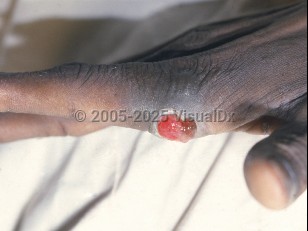Bacillary angiomatosis
Alerts and Notices
Important News & Links
Synopsis

Bacillary angiomatosis (BA) is most often caused by infection with Bartonella henselae or Bartonella quintana, gram-negative rods that stimulate the proliferation and migration of endothelial cells. Trauma from cats, such as cat scratches, bites, or licks, have been associated with B henselae infection, whereas being undomiciled and body louse infestation have been associated with B quintana infection. Rare cases of BA due to Bartonella elizabethae and Bartonella vinsonii (associated with canine exposure) have also been reported. BA is primarily seen in HIV-infected individuals with a CD4+ count of <100 cells/µl. It has been reported in patients immunocompromised by malignancy, immunosuppressive therapy, solid organ transplantation, and hepatitis B infection; it may very rarely occur in immunocompetent patients. It is rare in children.
BA is characterized by cutaneous angiomatous papules and nodules. Other cutaneous lesions include lichenoid plaques, subcutaneous nodules, and ulcers. Organisms may disseminate systemically, in which case cutaneous lesions may be accompanied by fever, malaise, and night sweats. Multiple internal organs – including the liver (known as bacillary peliosis hepatis), spleen, bone (lytic bone lesions often under cutaneous lesions, resulting in bone pain), lung (endobronchial nodules and pulmonary infiltrates), central nervous system (CNS), cerebral masses, cardiac (endocarditis), and gastrointestinal (GI) tract – may then be involved.
Upon appropriate treatment, cutaneous lesions resolve with some hyperpigmentation or scarring.
BA is characterized by cutaneous angiomatous papules and nodules. Other cutaneous lesions include lichenoid plaques, subcutaneous nodules, and ulcers. Organisms may disseminate systemically, in which case cutaneous lesions may be accompanied by fever, malaise, and night sweats. Multiple internal organs – including the liver (known as bacillary peliosis hepatis), spleen, bone (lytic bone lesions often under cutaneous lesions, resulting in bone pain), lung (endobronchial nodules and pulmonary infiltrates), central nervous system (CNS), cerebral masses, cardiac (endocarditis), and gastrointestinal (GI) tract – may then be involved.
Upon appropriate treatment, cutaneous lesions resolve with some hyperpigmentation or scarring.
Codes
ICD10CM:
A79.89 – Other specified rickettsioses
SNOMEDCT:
58213005 – Bacillary angiomatosis
A79.89 – Other specified rickettsioses
SNOMEDCT:
58213005 – Bacillary angiomatosis
Look For
Subscription Required
Diagnostic Pearls
Subscription Required
Differential Diagnosis & Pitfalls

To perform a comparison, select diagnoses from the classic differential
Subscription Required
Best Tests
Subscription Required
Management Pearls
Subscription Required
Therapy
Subscription Required
References
Subscription Required
Last Reviewed:01/01/2024
Last Updated:01/11/2024
Last Updated:01/11/2024
Bacillary angiomatosis

